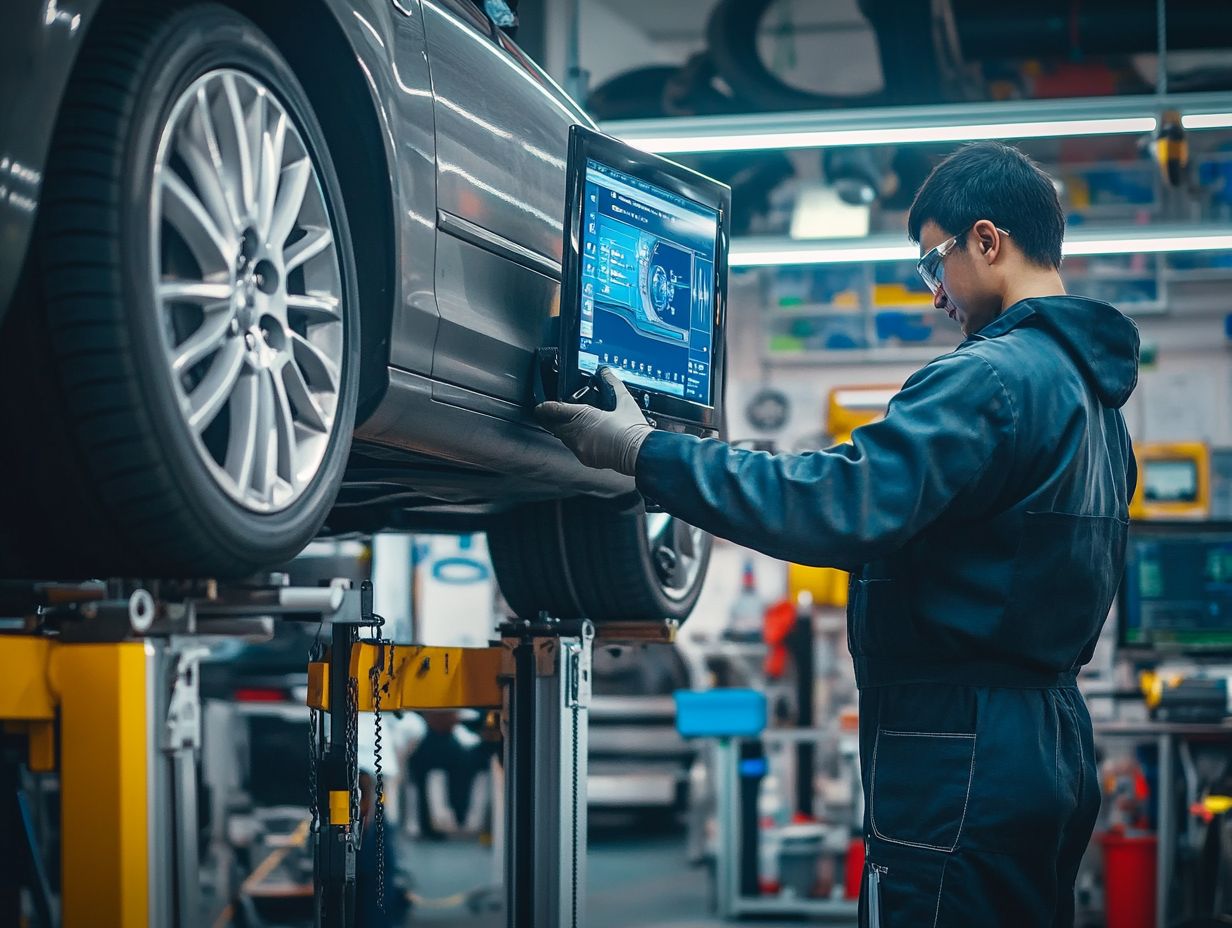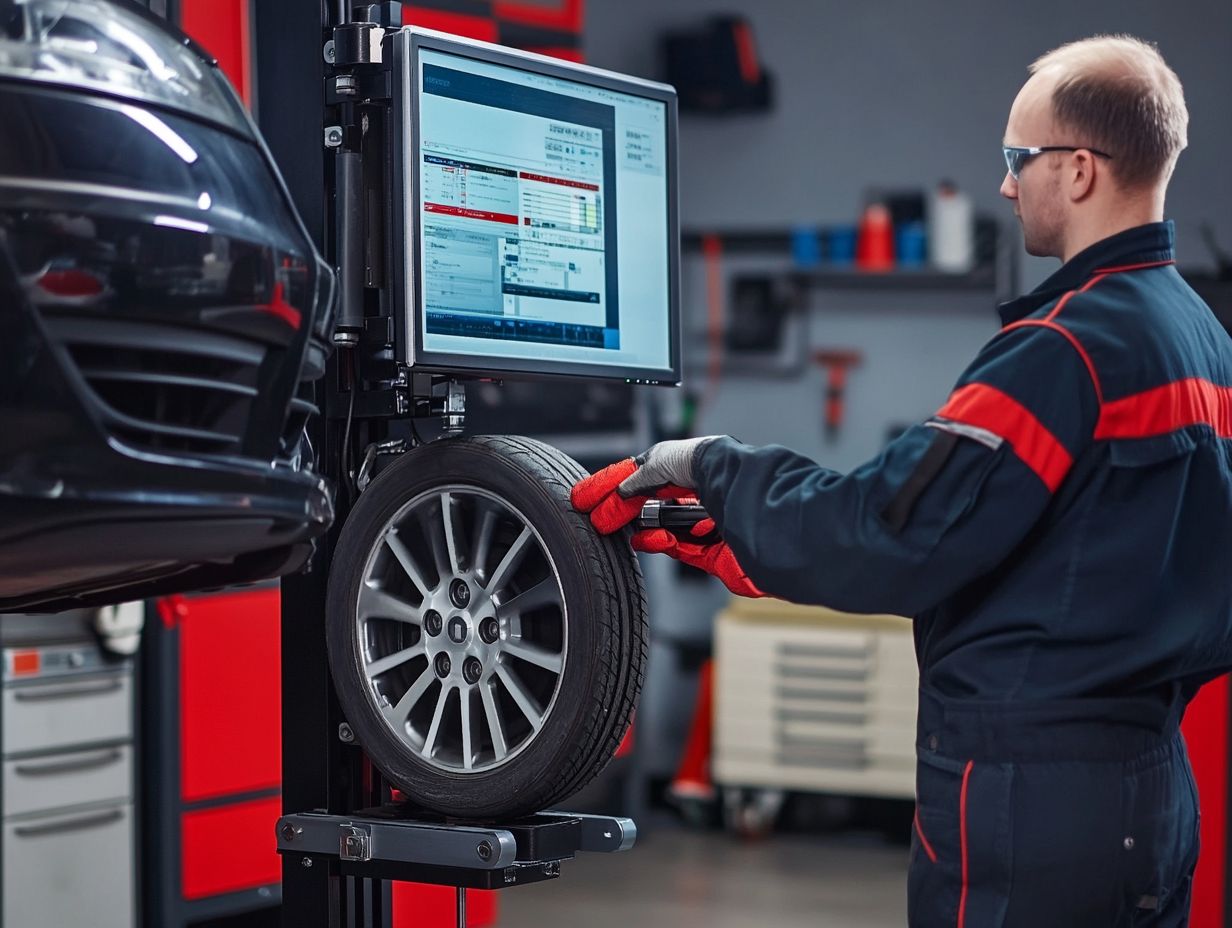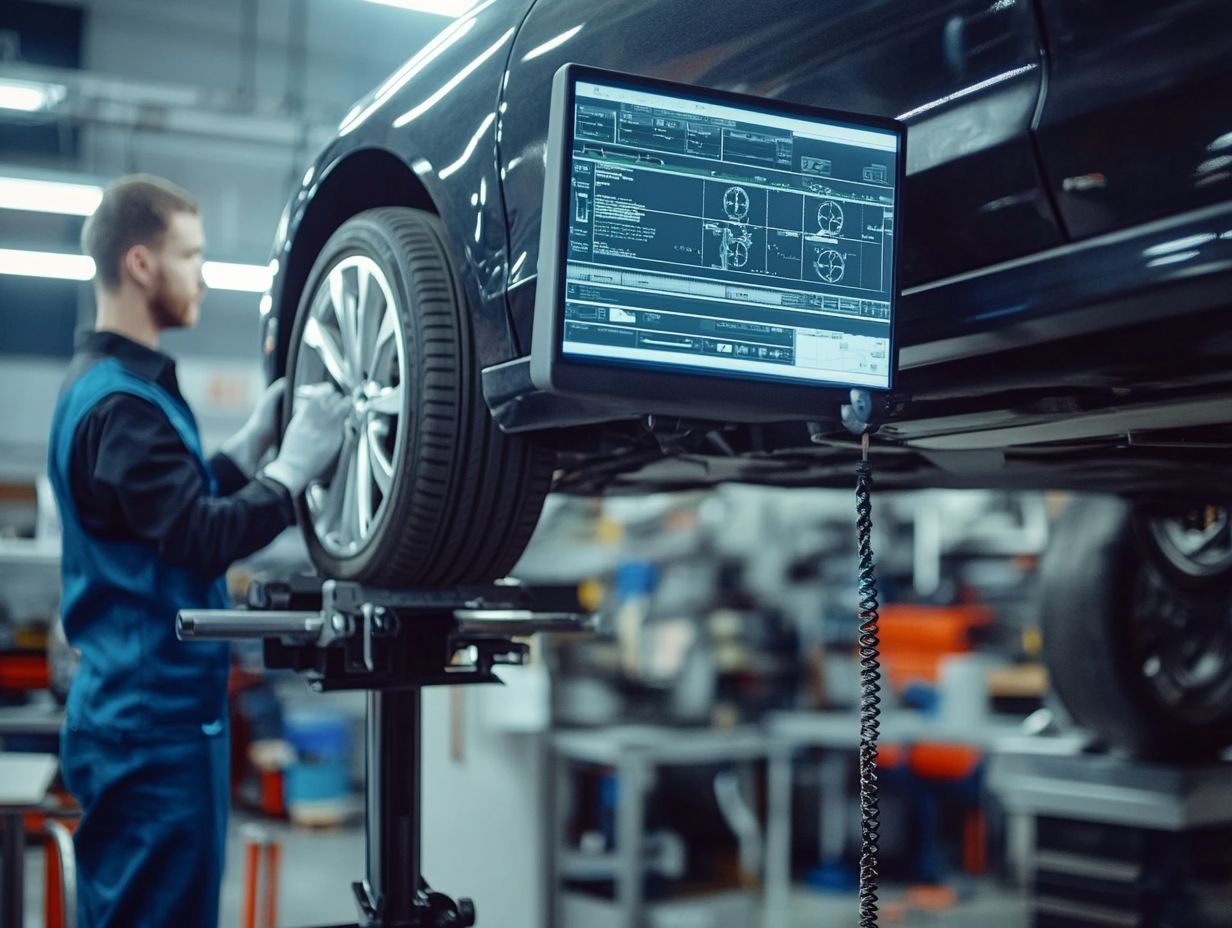What Are the Benefits of Regular Alignment Checks?
Maintaining your vehicle s performance involves more than routine oil changes and tire rotations. Regular wheel alignment checks are essential as well.
When your wheels are misaligned, you may face uneven tire wear, compromised safety, and decreased fuel efficiency.
This article delves into what wheel alignment is, why it s vital for your vehicle s well-being, and how you can identify the signs that indicate your car needs an adjustment. It will also cover how frequently you should schedule these checks and what you can expect during the process.
Keep reading to discover how to maintain a smooth and safe ride!
Contents
Key Takeaways:

- Experience smoother rides and greater safety with regular alignment checks!
- Misalignment can cause uneven tire wear and compromise safety, making regular checks crucial for maintaining optimal tire health.
- Get an alignment check every 6 months or every 6,000 to 10,000 miles to prevent potential issues and save on costly repairs in the long run.
What is a Wheel Alignment?
Wheel alignment, often referred to as vehicle alignment, is an essential element of auto maintenance that ensures your vehicle’s wheels are tuned to the manufacturer s specifications. This promotes optimal control and driving comfort.
Proper alignment means adjusting the angles of the wheels specifically, the angles that affect how they make contact with the road. This meticulous process boosts steering stability and plays a significant role in extending tire life, helping you avoid the hefty costs of premature replacements.
A professional technician employs advanced alignment technology to carry out precise adjustments that adhere to strict industry standards. With their expertise, they can identify potential issues before they escalate, driving satisfaction and peace of mind.
Regular checks and alignments keep all components working well together, leading to smoother rides and increased safety on the road. This highlights the importance of this often-overlooked aspect of vehicle care, ensuring that you enjoy every journey without a hitch.
The Importance of Regular Alignment Checks
Regular alignment checks are essential for preserving your vehicle’s optimal performance. They ensure that all wheels are aligned according to the manufacturer’s specifications, enhancing safety and extending the lifespan of your tires.
If you overlook this important maintenance task, you risk increased tire wear, elevated fuel consumption, and compromised vehicle handling factors that can significantly detract from your overall driving experience.
Benefits for Vehicle Performance
Ensuring proper wheel alignment brings significant advantages to your vehicle’s performance, enhancing driving stability, improving fuel efficiency, and increasing safety on the road. By addressing alignment issues through routine checks and professional adjustments, you ll enjoy a smoother ride and greater control over your vehicle.
When your wheels are aligned correctly, the suspension system the part of the vehicle that connects the wheels to the frame and helps absorb bumps operates more effectively, allowing for an even distribution of weight across all tires.
This not only reduces tire wear but also enhances grip, making your steering more responsive and predictable key factors in overall driving comfort. With aligned wheels, your vehicle consumes less fuel due to reduced rolling resistance, which can lead to substantial savings over time.
On the safety front, proper alignment minimizes the risk of skidding or losing control during sharp turns or sudden stops, ensuring everyone inside the vehicle remains secure.
Ignoring misalignment can trigger a cascade of issues, including compromised handling and increased repair costs. This highlights the importance of regular maintenance to guarantee optimal vehicle control.
Don’t wait! Schedule your wheel alignment check today and enjoy peace of mind on every drive!
Impact on Tire Wear and Safety

The impact of improper wheel alignment on tire wear and safety is significant. Misaligned wheels can lead to uneven tire wear, reduce tire longevity, and compromise your road safety. Regular alignment inspections are essential to identify and address any alignment issues, ensuring your tires wear evenly and perform at their best.
When your tires wear unevenly, it doesn’t just mean you’ll have to replace them sooner than expected; it also affects handling and overall vehicle performance. This situation can create dangerous conditions on the road, making it imperative for you to schedule routine inspections.
Professional technicians are invaluable in this process, using specialized equipment to accurately assess and correct alignment issues. By keeping your alignment in check, they extend the life of your tires and enhance your vehicle’s safety, ultimately providing you with a smoother ride and greater confidence behind the wheel.
Signs Your Vehicle Needs an Alignment Check
Spotting signs that your vehicle needs an alignment check is vital for your safety.
Look out for common indicators such as uneven tire wear, your vehicle pulling to one side, and vibrations in the steering wheel. These symptoms suggest your suspension system needs attention. Addressing them quickly boosts both safety and comfort on the road.
Common Symptoms of Misalignment
Common symptoms of misalignment include a steering wheel that seems off-center, your vehicle pulling to one side, and uneven tire wear patterns. These issues can seriously impact your driving comfort and safety. By identifying these signs early, you can save yourself money by avoiding more severe alignment problems and expensive repairs later on.
If your vehicle veers to one side, your front wheels may be misaligned. You might notice excessive wear on the inner or outer edges of your tires, which compromises both their lifespan and your safety.
An off-center steering wheel can make your driving experience less comfortable and complicate your control of the vehicle. Addressing misalignment promptly is essential. It improves how your vehicle handles, boosts fuel efficiency, and enhances overall safety on the road.
How Often Should You Get an Alignment Check?
Grasping the importance of alignment checks is essential for ensuring your vehicle performs at its best and remains compliant with warranty guidelines.
It is generally recommended to schedule an alignment check every 6,000 miles or at least once a year. This becomes particularly vital if you often navigate uneven surfaces or encounter potholes frequently. Prioritizing these checks can significantly enhance your driving experience and prolong the life of your vehicle.
Recommended Frequency

The recommended frequency for alignment checks can vary, but it s generally wise to have them performed every 6,000 miles or whenever you notice any signs of misalignment. Regular inspections are essential for ensuring optimal vehicle performance and enhancing your overall driving experience.
Driving conditions play a significant role in alignment. Encountering potholes, navigating rough terrain, or frequently hitting the highway can all impact your vehicle’s responsiveness. If you often find yourself in these challenging environments or regularly carry heavy loads, consider conducting alignment checks more frequently.
Misalignment can lead to uneven tire wear, reduced fuel efficiency, and compromised handling. By staying proactive and addressing alignment issues promptly, you can enjoy a smoother ride, ensuring that every journey is as enjoyable as it should be.
What to Expect During an Alignment Check
During an alignment check, you can expect a thorough inspection performed by skilled technicians using advanced alignment machines. These experts will carefully assess your vehicle’s alignment angles.
Camber refers to the tilt of the wheels, toe indicates the direction they point, and caster affects steering stability. This alignment process helps ensure your wheels are perfectly positioned, enhancing tire longevity and boosting fuel efficiency.
The Process and Potential Costs
The alignment process typically involves fine-tuning your wheels to meet manufacturer specifications. Costs can vary by service provider, but investing in alignment checks pays off in better safety and tire life.
Generally, the alignment steps begin with an initial inspection to evaluate the condition of your tires and suspension components. Next, precise measurements of camber, caster, and toe angles are taken. Adjustments may be necessary, followed by a final check to ensure everything aligns with the prescribed specifications.
Don t wait until your tires wear out unevenly. Turning to expert technicians can streamline the process and result in precise adjustments, protecting your tires from premature wear. This expert intervention proves invaluable over time, allowing you to appreciate improved vehicle performance and reduced maintenance expenses.
Frequently Asked Questions
What Are the Benefits of Regular Alignment Checks?

Regular alignment checks can help prolong the life of your vehicle’s tires and suspension components, highlighting the importance of tire alignment.
Why Should I Get Regular Alignment Checks?
Regular alignment checks can improve your vehicle’s handling and overall performance on the road.
How Often Should I Get Alignment Checks?
It is recommended to get alignment checks every 6,000 miles or once a year, whichever comes first.
Can Regular Alignment Checks Save Me Money?
Yes, regular alignment checks can help you avoid costly repairs and replacements by catching any issues early on.
What Happens if I Don’t Get Regular Alignment Checks?
If you neglect to get regular alignment checks, your vehicle’s tires may wear unevenly, and you may experience poor handling and decreased fuel efficiency.
Are There Any Safety Benefits to Regular Alignment Checks?
Yes, regular alignment checks can improve your vehicle’s stability and reduce the risk of accidents caused by poor handling or worn tires.






